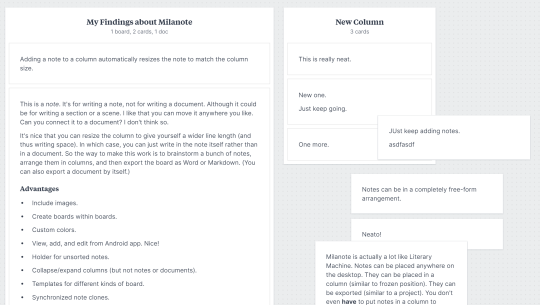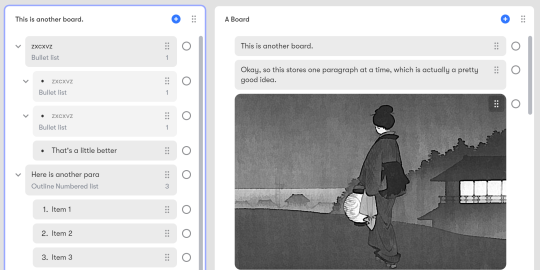From Editorium:
You can’t do much carpentry with your bare hands, and you can’t do much thinking with your bare brain. —Bo Dahlbom
High school English class. Freshman year. The teacher explained how to:
- Come up with a thesis statement.
- Create an outline of arguments supporting the thesis statement.
- Write a paper based on that outline.
That’s actually a terrible way to write! It requires you to organize your thoughts before you know what those thoughts actually are. But there is a better way.
Brainstorm, Organize, Write
What are your thoughts about a particular subject? In the days before computers, you’d find out like this:
- Get a package of index cards, something like these.
- On each card, write an idea related to your thesis (the fancy word for whatever it is you want to write about). Do not try to do this in any kind of order; you’re brainstorming here: good ideas, bad ideas, any ideas—they all go down on the cards. When your brain is empty, stop.
- On a big desk or table, spread the cards out in front of you. Keep them messy.
- Read the cards and stack those on a certain subject together until you have several stacks. Discard (pardon the pun) those that don’t belong anywhere or that now seem irrelevant or stupid.
- Put the cards in each stack in some kind of order. Importance? Chronology? You choose.
- Put the stacks in some kind of order. Each stack represents a section of your paper.
After you’ve captured and organized your thoughts, write your paper, starting with the first card and ending with the last. Each stack gets a subheading. Each card gets a paragraph. When you’re finished, edit your paper as needed.
Card-Based Writing Programs
But, again, that was in the days before computers. We now have much better ways of doing what I’ve just described, with new card-based writing programs popping up all the time.
. . . .
Milanote

Milanote is the most expensive of the programs listed here, but it’s also the slickest. Cards can be created and then placed on the screen in any order you like. After you have them all down, organize them into columns. Finally, export the whole thing as a Word document, a Markdown document, or plain text, ready for editing. Milanote is elegant, a pleasure to use.
Speare

Speare doesn’t support free-form card placement; each paragraph is a card, and all cards must be arranged in a “board.” After creating and organizing your cards, “compile” them into a document, copy the document, and paste into Word or another word processor.
Link to the rest at Editorium
PG would be interested in hearing from visitors to TPV who use or have used programs like those described in the OP. He’d be interested to understand the pluses and minuses of using something other than a word processor.
The first lines,
That’s actually a terrible way to write! It requires you to organize your thoughts before you know what those thoughts actually are. But there is a better way.
Put this into infomercial territory, where the people using basic products are oddly incompetent with them, and need the infomercial product to perform basic tasks. Students don’t come up with a thesis out of the blue; they already have a topic and thoughts or knowledge about that topic. The thesis comes from that.
But yeah, nothing in this “infomercial” convinces me to move away from Scrivener, which lends itself well to organizing ideas. I like to use a folder for “unplaced scenes,” where you put scenes you’ve written outside of the current flow of the story. Maybe you’ve thought of a set piece that belongs in act 2, but you thought of it while writing your Inciting Incident in act 1. Into the “unplaced scenes” folder you go.
The corkboard feature where scenes or chapters appear as index cards helps, too. I often write “epigrams” for a scene or chapter, e.g., “in which Sleuth investigates,” “in which the fellowship forms a new strategy” and so forth. If a scene/chapter lacks an epigram, or it’s weak, e.g., “in which the heroine drinks tea,” that’s a clue to reexamine that chapter or scene.
I “plants” (plan and pants) stories. Scrivener lets me have an outline, a story bible, and a research folder and manuscript all in the same “binder.” With writing I’m used to weaving tapestries and organizing in my head as I “pants,” but I’ve learned the value of writing down the threads I’m weaving. Sometimes, I have no choice but to step away from a project, and it’s easier to pick up the threads again if I at least recorded what I thought the end product would look like (the “plan”).
This is why I side-eye the idea of writers taking up the unfinished work of other writers. Even with the notes I write down, much of it remains in my head and a lot of it is instinct. A writing journal comes in handy to reacquaint me with my own ideas, but even so. Even the most ardent of planners, e.g., J.K. Rowling, will give way when they notice a plan either does not need to be carried out in a particular way, or the story or characters present a better idea.
I’ll probably never use the OP’s suggested programs, but I do want to encourage other writers to experiment with what works best for them.
Organizing before you have content vs. gathering content before deciding how to organize it are just different ways to think of plotting vs. pantsing.
Some people want discovery AS they write, saying if they knew where they were going there would be no reason to go; others want it all planned out and with tickets so they know where they’re sleeping every night – so they can relax and enjoy each stop.
The English teacher’s problem is in knowing only one way – probably theirs – to do things, thus leaving roughly half the students unsupported.
My recommendation to newbies is to be on the lookout for which end of the writing spectrum is your natural location. Because I wasted YEARS trying to write like Lawrence Block – pantsing and I are not compatible, not if the output matters.
Like any craft, until you are actually hands-on, it’s difficult to know what approaches will work best for you. School is for learning the existence of various tools (and crafts), but it can’t send everyone down the various crafts’ ways at that age.
Of course, a teacher who’s not actually in the craft and thus somewhat familiar with craft choices can be misleading in their absolute confidence about the best approaches.
Big fan of Scrivener.
While the dedicated products described in the OP are appealing, Scrivener would support that, and more.
I find I move my completed novels into Word before splitting treatments into Print vs Ebook variants, because Word has a more sophisticated search/replace technology which I use not just for funky-character fill-ins (e.g., accented characters), but also for pre-HTML replacements (HTML special characters for punctuation, etc.). That allows me to easily split the two output needs for subsequent specialized formatting.
I am interested in Atticus, and may experiment with it for my next novel to see if I still need to split the output process between print and ebook, but only for the formatting stage — I’d rather do my writing in Scrivener.
I can see the use of a product like Milanote, but not for long forms. Might be a quick-and-dirty tool for some blog posts which are more awkward to construct directly in WordPress. On the other hand, I could just set up the same process in a Scrivener template without any extra cost. And on the third hand, I’m also a fan/user of OneNote, which could also be used that way, but more awkwardly. OneNote is totally free-form — you have to impose your own conceptual structures. Scrivener is medium free-form, and the structure it provides for “notes” and “images” gets you usefully there already.
I have used Scrivener since I discovered it back in 2011 or so. I particularly like the color coding I can use for various scenes/chapters to help organize my output. In some instances I will write an entire character using color coding in scenes/chapters in order that I can distribute the results throughout my novel and recognize them at will.
When I’m satisfied with a final version, I dump it into Word for ebook formatting for upload to a wide variety of distributors. I load the final Word version into Affinity Publisher to be formatted for Ingram Spark and Amazon POD printing. I do a cover in Affinity Photo using KDP’s template, and Ingram Spark’s template.
Thanks to Scrivener, I have around 50 ebooks and 15 POD books for sale around the world.
I’m confused by the description, but it sounds as though Scrivener is the same deal. You can make notes, move them around, and then print the result. I will say about Scrivener that I’ve only been using it for nine months and was completely unable to produce a manuscript that didn’t need some intensive work in a followup word processing program. However, with only the word processor I couldn’t stay organized. I just finished the book and put it up so three cheers for Scrivener, which by the way had a one time cost rather than a subscription.